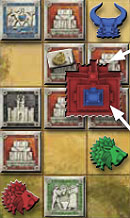

Monument building can occur when someone places a tile. There are six monuments in the game. Each monument consists of two different-colored parts; be sure to assemble these in the correct configuration.
If the active player places a tile in such a way that he creates a 2x2 square of four like-colored tiles, he may flip those four tiles facedown and place a monument on top of them. One color of the monument must match the facedown tiles. If that color is no longer available, the monument cannot be built, and therefore the tiles cannot be flipped facedown.

If tile placement initiates a war, the players must resolve the conflict before flipping tiles facedown. If the square still exists after resolving the conflict, the active player may build a monument.
If the player completing the square does not build a monument as part of his current action, the tiles remain faceup. A monument can be built only at the end of the action in which the active player completed a 2x2 square.
The four facedown tiles still count as part of regions and kingdoms, linking leaders and tiles. However, they no longer count for any other functions (e.g., as supporters in conflicts).
A monument cannot be destroyed.
When four temples are flipped facedown and a monument is built, the following applies:
- If a treasure lies on a temple, it remains on that facedown tile.
- If a leader is no longer adjacent to a temple, withdraw that leader and return it to the player.
Example 3: By turning the temples facedown, the Bull player elects to create a red and blue monument.
A monument regularly provides victory points. At the end of the active player's turn, he determines if one or more of his leaders are in the same kingdom as a like-colored monument.
For each such leader, he gains one victory point of the leader's color for each like-colored monument in the same kingdom. For example, if he has a blue leader (farmer) in a kingdom with a blue monument, he gains a blue victory point (crop). Since a monument has two colors, it can provide victory points for up to two leaders each turn.
A king gains a victory point only when linked to a black monument. While the placement of a tile can allow a king to gain victory points in other colors (in the absence of the respective leaders), this does not apply for monuments.
Continue Reading

